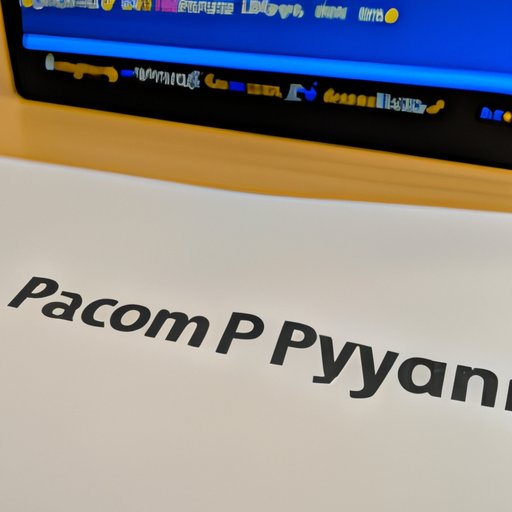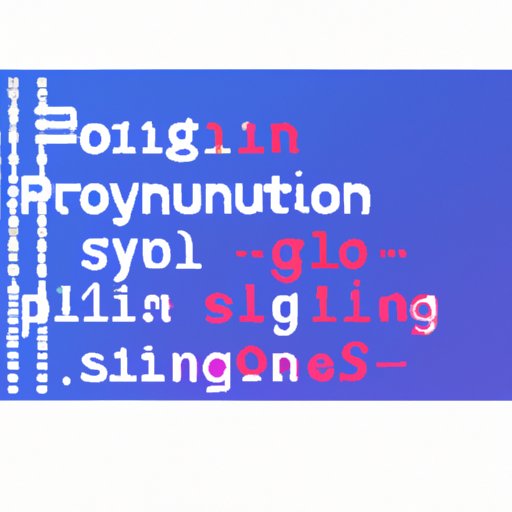Introduction
Computer programming is the process of writing instructions for computers to execute. The instructions are written in a programming language, such as Python, which is then translated into machine code that the computer can understand and execute. Python is an open source, interpreted high-level programming language used for general purpose programming. It has a simple syntax, making it easy to learn and use, and is widely used in web development, software development, data science, and scientific computing.

Exploring the Basics of Python Programming
Before you can write a program in Python, you need to understand the fundamentals of the language. This includes understanding variables, data types, and operators. Variables are used to store values, such as numbers, strings, or objects. Data types define the type of data stored in a variable, such as integers, floats, and strings. Operators are used to perform operations on variables, such as addition, subtraction, and multiplication.
You also need to understand how to control the flow of a program with conditionals. Conditionals are statements that allow you to test if certain conditions are met before executing certain lines of code. For example, you could use an if statement to check if a number is greater than 10 before executing a certain line of code.
Finally, you need to understand how to use loops to repeat code. Loops allow you to execute certain lines of code multiple times, which can be useful for performing repetitive tasks. There are two types of loops in Python: for loops and while loops. For loops are used to iterate over a sequence of items, such as a list or string, while while loops are used to execute a block of code until a certain condition is met.
What is a Program and How Does it Work?
A program is a set of instructions that tells a computer what to do. In order for a computer to understand these instructions, they must be written in a programming language, such as Python. Once the instructions have been written, the program must be compiled, which means that the instructions are translated into machine code that the computer can understand. The machine code is then executed by the computer, which causes the computer to follow the instructions given in the program.
The anatomy of a program consists of commands, variables, and functions. Commands are instructions that tell the computer what to do, such as printing a message or calculating a value. Variables are used to store values, such as numbers or strings. Functions are reusable pieces of code that can be used to perform a specific task, such as calculating the average of a list of numbers.

Writing Your First Program in Python
Now that you understand the basics of Python programming, it’s time to write your first program. To get started, you’ll need to set up a development environment. This involves installing Python and any necessary libraries, such as NumPy or SciPy. Once you’ve installed Python and the necessary libraries, you’re ready to create your first program.
Creating a basic program in Python is relatively straightforward. You start by writing the instructions for the program in the form of commands and variables. Once you’ve written the code, you can compile it and run it to see if it works as expected. If not, you can go back and edit the code until it works correctly.
It’s important to understand the code that you write. To do this, you should read through the code line by line and make sure you understand what each line does. If there is something you don’t understand, look it up in the documentation or ask a question on Stack Overflow.
Constructing Programs with Variables and Functions
Once you’ve written your first program, you can start constructing more complex programs using variables and functions. Variables are used to store values, such as numbers, strings, or objects. Understanding how to define and use variables is key to writing efficient programs. Functions are reusable pieces of code that can be used to perform a specific task, such as calculating the average of a list of numbers. You can either use built-in functions, such as the sum() function, or create your own custom functions.
Object-Oriented Programming in Python
Object-oriented programming (OOP) is a programming paradigm that uses objects to model real-world entities. In OOP, objects are created from classes which define their properties and methods. Objects can then be used to create other objects, allowing you to create complex programs. In Python, you can use classes to define objects and use inheritance to create objects from existing classes.

Debugging and Troubleshooting Python Programs
Debugging and troubleshooting are important skills for any programmer. Debugging is the process of identifying and resolving errors in a program. In Python, you can use debugging tools such as pdb and ipdb to help identify and resolve errors. When troubleshooting a program, it’s important to read through the code line by line and make sure you understand what each line does. Additionally, you should use print statements to output values and check if they are what you expect.
Conclusion
Computer programming in Python is a powerful skill to have. In this article, we explored the basics of Python programming, from understanding what a program is to writing your first program. We also discussed variables, functions, objects, and debugging. With this knowledge, you can start writing your own programs in Python and continue learning more about the language.
(Note: Is this article not meeting your expectations? Do you have knowledge or insights to share? Unlock new opportunities and expand your reach by joining our authors team. Click Registration to join us and share your expertise with our readers.)
